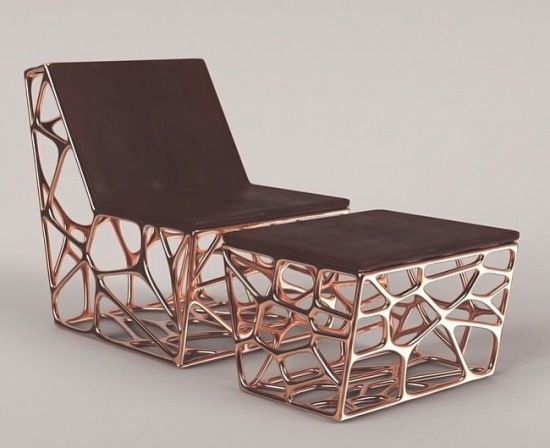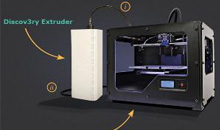
Pizza, working cars, entire office buildings, tiny power tools — is there anything that can’t be made with a 3D printer? Over the last several years the world has seen 3D printing shake up a number of industries. It seems as if there’s noting one can’t have printed these days, and now this technology is changing the world of furniture, too. Lamps, chairs, tables, and decorative hardware are now being printed, and it’s quickly changing how companies produce pieces as well as increasing the options available to consumers.
Changing the Design Process
One part of the furniture business that has traditionally required significant time and financial investment is the design process. Prototypes have to be made, models tested, and pieces reworked to reach a final product. 3D printing streamlines, simplifies, and reduces the cost of designing furniture. Being able to create lightweight furniture prototypes quickly and inexpensively with 3D printing enables designers to test their creations more thoroughly and maximize the beneficial features in the finished product. UK design firm Cohda collaborated with 3D printer Freedom of Creative to produce the Binary Furniture Collection. It’s styled to resemble designs made by an old school Spirograph, and being able to electronically sketch and then print each piece has made the collection affordable for the business and their customers.
A rapidly growing number of furniture design firms are experimenting with 3D printing, and the results have been quite creative. With less production and design expenses, 3D printing lets companies develop furniture that is as beautiful to look at as it is functional. The One Shot stool, designed by Patrick Jouin, is a 3D printed piece that folds up to save space when not in use and elegantly fans out when an extra seat is needed. Its aesthetic is unlike that of most other stools, and that’s what makes the One Shot’s design so attractive to those who like modern furniture.
Patrick Jouin also designed a light, called Bloom, for Materialise that is an articulated lamp produced via 3D printing. The shade opens and closes, resembling a lotus flower. Incredibly, Bloom is printed in one piece and requires no assembly at all. It’s just one of a number of innovative pieces that are coming to the furniture market and expanding consumer options like never before.
Manufacturing Revolution
In addition to giving designers the ability to create furniture that’s simply not possible to make by traditional methods, 3D printing has made it cheaper for new businesses to enter the furniture game. Less design and production expenses equates to furniture that can quickly be made available to consumers at a lower price on both ends. It’s truly a win-win for designers, manufacturers, and people who want awesome furniture without spending an arm and a leg.
Since its inception, the 3D printing industry as a whole has grown over 45 percent each year. In 2013 the market was valued at $2.5 billion, and the projected value is estimated to each $16 billion by the year 2018. This technology allows furniture design firms and retailers of home goods to increase their bottom lines, waste significantly less resources and energy, and make production much more efficient.
3D printing is not only more cost effective for companies, it’s much more environmentally friendly and sustainable than most traditional means of creating furniture. Dirk Vander Kooij’s Pulse Chair is made via 3D printing and comprised of discarded refrigerators that have been melted down. The result is a piece that’s durable and strong, yet lightweight. As an eco-conscious bonus, the Pulse Chair itself can be recycled.
Consumer Benefits
Custom designed furniture has historically been cost prohibitive because of the costs involved on the business end, but printed furniture eliminates some of that burden. Not only is designing prototypes made easier with this technology, getting finished pieces to customers is as well. They can choose their preferred colors, styles, and other customized options and it won’t add any additional cost to the printing process.
While 3D printing will change many segments of the furniture industry, it won’t replace traditional manufacturing or upholstery entirely. Those who prefer classic designs or pieces crafted of exotic woods and materials are unlikely to start favoring the very modern style of furniture that 3D printing produces. However, consumers who want their furniture to look like a trendy Pinterest board, custom artwork, or minimalist piece will find it very easy to love 3D printed furniture.
Peter Donders is a Belgian furniture designer who developed the Batoidea Chair and creates each one with the aid of 3D printing. It’s an airy piece of furniture with attractive twists and curves, and it can be printed in various colors. Similar chairs made of metal cost many times more than Donders’ printed design, and he says that without additive manufacturing, creating the Batoidea Chair would result in a great amount of waste.
In addition to having a much wider array of designs to choose from and the ability to easily obtain custom pieces, 3D printed furniture is easier on the wallet than traditionally manufactured furniture. Whereas a custom table would cost thousands of dollars, a printed one would cost a few hundred, if that. It’s much quicker to actually get the furniture in hand as well. Designer Dirk Vander Kooij can create furniture with his 3D printer, dubbed Furoc, within a three hour time span. That’s incredibly faster than the time it takes to make non-printed furniture, and it’s even 40 times faster than most 3D printers.
This speed will change furniture shopping as consumers have come to know it. In the very near future, customers will be able to go to locations nearest them and get their chairs, tables, and fixtures 3D printed on the spot. Imagine being able to look at a piece of furniture online, have it printed, and then pick it up the same day — it’s a very real possibility, and shoppers and retailers can expect it to become reality in just a few years. Lower production costs, endless design possibilities, happy consumers — it’s no wonder 3D printing is taking the furniture industry by storm.
(Source: Housely.com Author: Nathaniel Berman)


























 沪公网安备31010402003309号
沪公网安备31010402003309号